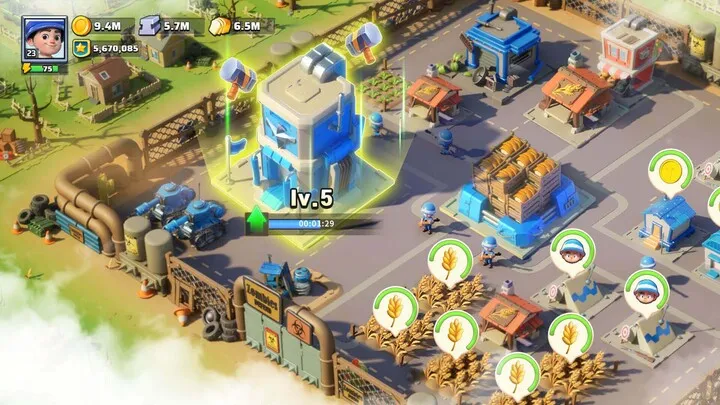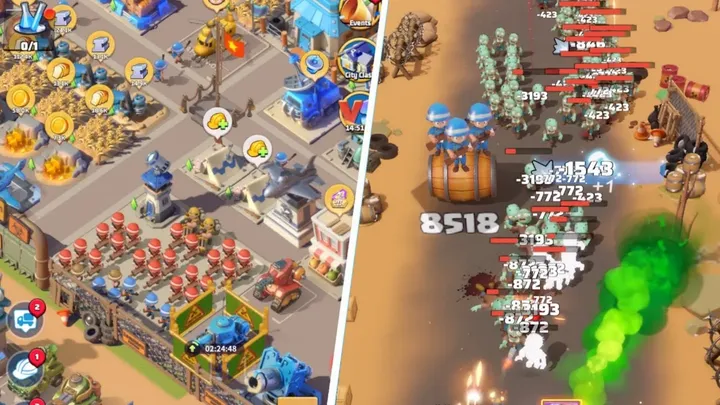Last War: Survival isn’t just about shooting enemies or gathering supplies—it’s a slow and strategic conquest of endurance. Every decision you make about your base determines your strength in the late game. Many new players focus on quick resource farming or unit training, but true mastery lies in building a base that sustains itself: a fortress that produces, defends, and evolves without constant micromanagement. This article explores how to build a self-sustaining base in Last War: Survival, analyzing every step from the first foundation to late-game optimization. Each section unfolds chronologically, revealing how to build smarter, not faster—balancing economy, defense, and research in a world where one mistake can end everything.\

1. Laying the Foundation: Choosing and Structuring Your Base Location
Every successful survival journey begins with a stable foundation. In Last War: Survival, the early game is all about positioning and structure. You may not realize it at first, but the placement of your base determines your efficiency for the next dozens of hours.
The Importance of Terrain and Resource Proximity
When first establishing your base, select a region close to essential resources such as metal veins and oil fields. These zones allow faster early harvesting and reduce the travel time of supply convoys. Avoid overly contested areas, as aggressive neighbors can cripple your early progress.
Core Structure Placement Strategy
Your Command Center should be placed centrally, surrounded by essential production buildings—farms, metal mines, and refineries. Place storages near production zones to shorten delivery routes. The outer ring of your base should contain defensive walls and training facilities.
Early Stage Goals
- Prioritize Command Center upgrades.
- Build at least one of each production building before doubling any.
- Set up a logical grid layout that anticipates expansion rather than reacts to it.
Establishing an efficient base layout early prevents future resource congestion and paves the way for automated efficiency later on.
2. Powering Growth: How to Maintain Stable Resource Production
A self-sustaining base relies on balance—food, oil, and metal are your economic triad. Neglect one, and your system collapses.
Understanding Production Ratios
Every upgrade demands a different resource ratio. Early buildings consume more food, while later tech and defense rely heavily on metal and oil. Adjust production dynamically: don’t overproduce food once your troop growth stabilizes.
Resource Scaling Over Time
Instead of endlessly building more production structures, focus on upgrading existing ones. Higher-level facilities are more space-efficient and easier to defend. Pair upgrades with tech research that boosts yield percentages to maximize returns.
Avoiding Overproduction Wastage
When storages are full, production halts—essentially wasting time. Keep construction projects or troop training active to drain resources continuously. A steady flow keeps your base efficient.
A balanced economy isn’t just about generating resources—it’s about maintaining constant circulation.
3. Securing Stability: How to Build Defense Without Weakening Growth
Defense in Last War: Survival isn’t just about brute force—it’s about timing and placement. Building defense too early can choke economic growth; too late, and you’ll lose everything.
The Layered Wall Principle
Use multi-layered walls to protect key infrastructure. The outermost ring should absorb damage; the inner ring should protect critical assets like the Command Center, storages, and power plants.
Turret Efficiency and Positioning
Early on, general-purpose turrets are sufficient. As enemies evolve, specialize:
- Anti-Infantry Turrets near barracks
- Anti-Vehicle Cannons at gate entrances
- Missile Towers protecting Command Centers
Defense Maintenance Routine
Repair structures immediately after battles. Neglected damage weakens your base exponentially. Set a daily repair schedule and automate patrol units to reduce surprise raids.
Balanced defense preserves your base’s life without draining its economy.
4. Command Center Mastery: The Pulse of Base Progression

The Command Center is the brain of your survival empire. Its level determines every major advancement in your gameplay.
The Golden Rule of Upgrading
Never let your Command Center fall behind your other structures. Each level unlocks new buildings, tech tiers, and troop capacities. Plan upgrades ahead by preparing all necessary materials in advance to avoid idle time.
Strategic Timing
Always begin Command Center upgrades when you plan to log off or take breaks—they take the longest. This maximizes uptime and ensures that no productive hour is wasted.
Synergy with Supporting Buildings
Each Command Center upgrade has dependencies—such as higher-level resource depots or power stations. Upgrade them simultaneously to streamline future progress.
Your Command Center’s pace is your base’s heartbeat—keep it steady and strong.
5. Research and Technology: Building Long-Term Efficiency
The Research Lab defines the hidden power of your base. Behind every visible structure, invisible tech upgrades quietly multiply your efficiency.
Economic Research First
Always prioritize tech that boosts production, reduces construction time, or increases storage capacity. These bonuses stack multiplicatively, meaning even a small early investment yields enormous long-term gains.
Transitioning to Military Research
Once your economy stabilizes, pivot toward military technologies. Focus on troop health, vehicle armor, and turret attack rates to sustain both offensive and defensive power.
Continuous Research Loop
Research takes time—never let your lab sit idle. Queue new projects during sleep hours or when you’re offline. Over months of play, continuous research defines the power gap between average and elite players.
Technological progression ensures your base remains relevant even when facing stronger opponents.
6. Training and Troop Management: Maintaining a Self-Sufficient Army
Troops in Last War: Survival are both protectors and consumers. Balancing them with your economy is vital for long-term self-sufficiency.
Efficient Training Cycles
Keep training facilities running at all times, but match your troop numbers with your resource output. Overtraining leads to food shortages, crippling production.
Unit Diversity and Balance
Build armies with layered compositions—infantry for defense, vehicles for offense, and artillery for support. Different situations call for different strengths, and maintaining versatility prevents one-dimensional weaknesses.
Recycling and Recovery
Regularly retire outdated units to reclaim resources or open training slots. Keeping your army modern reduces upkeep costs and maximizes combat effectiveness.
Sustainable military strength comes from discipline, not constant expansion.
7. Outposts and Expansion: Extending Your Influence Wisely

Once your base can sustain itself, expansion becomes the next frontier. Outposts represent your reach into the larger world.
Choosing Outpost Locations
Position outposts near high-value resource fields or trade hubs. Avoid contested zones unless your alliance can defend them collectively.
Linking Supply Lines
Create stable transport routes between your main base and outposts. Secure them with defensive units to prevent interception during resource transport.
Outpost Autonomy
Develop outposts to function semi-independently—each with its own small production and defense system. This reduces dependency on your main base and improves resilience.
Expansion is not just growth—it’s insurance against collapse.
8. Alliance Integration: How Cooperation Fuels Self-Sufficiency
In Last War: Survival, self-sufficiency doesn’t mean isolation. Alliances multiply your power through collective benefits.
Alliance Resource Sharing
Share and request materials regularly. Trading ensures no single member suffers production downtime, keeping the alliance ecosystem healthy.
Defense Reinforcement Protocols
Alliances can send defensive reinforcements during attacks. Coordinate times for guard rotations to ensure constant protection during inactive hours.
Alliance Research Contributions
Join collective research projects that boost construction or training speed for everyone. Even small contributions add up, benefiting the entire group.
An alliance is a living organism—its strength feeds yours, and vice versa.
9. Automation and Time Optimization: Turning Daily Tasks into Systems
A truly self-sustaining base runs itself efficiently with minimal player input.
Routine Scheduling
Divide your daily cycle into production checks, training updates, and construction planning. Set reminders or timers to maintain consistency without overplaying.
Using Boosts Intelligently
Save temporary production or speed boosts for synchronized phases—like when you’re upgrading multiple resource buildings simultaneously. This compounds efficiency.
Event Synergy
Align upgrades and training with timed game events that reward additional resources. This “stacking” method accelerates growth passively.
Automation isn’t a feature—it’s a mindset of structured, deliberate play.
10. The Endgame Fortress: Sustaining Power Without Constant Micromanagement

By the time your base reaches its peak, true mastery means maintaining dominance without burnout.
Power Redistribution
Shift focus from rapid growth to stabilization. Redistribute resources toward upkeep, trade, and alliance support rather than expansion.
Preparing for the Unexpected
Always keep emergency reserves—metal for rebuilding, food for troops, and oil for vehicles. In Last War: Survival, peace is temporary.
Legacy Management
Your base should eventually operate as a fortress that regenerates resources and defends itself with minimal input. That’s the pinnacle of sustainability—a system that thrives even when you’re offline.
The endgame isn’t about endless growth—it’s about achieving perpetual motion.
Conclusion
Building a self-sustaining base in Last War: Survival is a process of balance, patience, and precision. From your first wall placement to your final Command Center upgrade, every decision you make contributes to the harmony of survival and progress. The secret isn’t speed—it’s strategy: understanding the interdependence of economy, defense, research, and alliances. A truly successful player doesn’t just survive the apocalypse—they build a machine that thrives within it, self-powered and unstoppable.

















